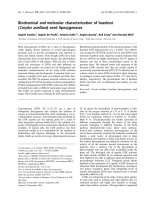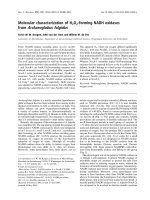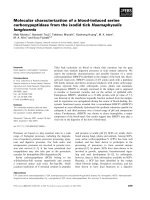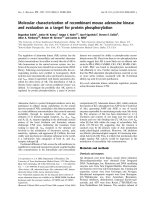Molecular characterization of Alternaria alternata causing fruit rot of chilli through RAPD marker
Bạn đang xem bản rút gọn của tài liệu. Xem và tải ngay bản đầy đủ của tài liệu tại đây (267.98 KB, 7 trang )
Int.J.Curr.Microbiol.App.Sci (2018) 7(3): 292-298
International Journal of Current Microbiology and Applied Sciences
ISSN: 2319-7706 Volume 7 Number 03 (2018)
Journal homepage:
Original Research Article
/>
Molecular Characterization of Alternaria alternata Causing Fruit Rot of
Chilli through RAPD Marker
Kajal Jankar1, Ekta Bagde1, Someshree Mane1, Divya Jambhure2 and Ashwini Kumar3*
1
Department of Plant Pathology, Post graduate Institute, Akola-444104, India
2
Department of Plant Pathology, Dr. BSKKV, Dapoli- 415712, India
3
Department of Plant Pathology, JNKVV, Jabalpur-482001, India
*Corresponding author
ABSTRACT
Keywords
Random Amplification of
Polymorphic DNA, Molecular
characterization, Alternaria
alternata, Chilli, fruit rot
Article Info
Accepted:
04 February 2018
Available Online:
10 March 2018
Molecular variation in chilli fruit rot pathogen (Alternata alternata) was analyzed by using
six isolates collected from major chilli growing region of Maharashtra. The genomic DNA
extracted from each isolate of A. alternata was subjected to polymerase chain reaction
using 15 primers of OPA and OPB series off which 10 primers produced 83 scorable bands
with size ranging from Among the RAPD primer 83 bands 80 bands were polymorphic
and level of polymorphism was 96.38%. Molecular diversity using RAPD marker showed
that the Aa2 (Satara) having higher similarity index with Aa4 (Akola). Dendrogram
generated by pooled molecular data of 10 RAPD primers formed two clusters namely ‘A’
and ‘B’.cluster A include Aa1 and cluster B include Aa2, Aa4, Aa3, Aa5 and Aa6. Thus,
the molecular characterization of eight isolates of A. alternate by RAPD revealed existence
of variations.
Introduction
Chilli (Capsicum annuum L.) is one of the
most important commercial spice and export
crop originated from Tropical America.
It is grown throughout the world for its green
and red ripe fruit.
(Sreekantiah et al., 1973). In India, the first
report of Alternaria sp. was made from Delhi
by Dutt in 1937. Narain et al., (2000) reported
Alternaria alternata causing fruit rot of chilli
on fruits. The present study carried out to
ascertain molecular polymorphism in different
isolates of Alternaria alternata.
Materials and Methods
The crop is vulnerable to many diseases and
pests due to its extreme delicacy and
succulence. Diseases caused by fungi, bacteria
and viruses are major constrains to chilli
production. Among the fungal diseases, fruit
rot is a major constraint in chilli causing
several losses in terms of quality and quantity
The experimental materials comprising eight
Alternaria alternata isolates viz., Kolhapur
(Aa1), Satara (Aa2), Sangli (Aa3), Akola
(Aa4), Nagpur (Aa5) and Amravati (Aa6)
collected from different chilli growing
districts of Maharashtra.
292
Int.J.Curr.Microbiol.App.Sci (2018) 7(3): 292-298
DNA isolation of A. alternata
The DNA was extracted from eight isolates of
Alternaria alternata. Potato dextrose agar
medium was used to culture the isolates and
mycelia were harvested after 7 days of
incubation as described by Coddington and
Gould (1992). DNA extraction of the isolates
of A. alternate and their further molecular
characterization were done by Cetyltrimethyl
ammonium bromide (CTAB).
Protocol for isolation of fungal genomic
DNA
Then equal volume (1 ml) of chloroform
isoamylalcohol (24:1) was added and mixed
gently but thoroughly to emulsify both the
components for five minute.
Centrifugation was carried out at 12000 rpm
for 15 min.
The upper aqueous phase was transferred into
another 2 ml eppendorf tube.
Equal volume of ice-cold isopropanol was
added and mixed by inversions. CTAB-DNA
complexes formed at the bottom of the
eppendorf tubes.
The pure culture of fungus grown on potato
broth 200 ml in 500 ml conical flask for seven
days at a temperature of 27± 2°C in BOD
incubator.
After mixing with isopropanol, the sample
were kept at 40 C for 10 minutes and then
centrifuged at 10000 rpm for 10 minutes.
The mycelial mat was harvested after seven
days.
After centrifugation a pellet was formed at the
bottom of the eppendorf tube.
It was wash thoroughly and repeatedly and
then dried using blotter paper and crushed to
powdered form in pre-chilled pestle and
mortar with liquid nitrogen. The powdered
mass was immediately homogenized by
adding pre-warmed (650 C) 1 ml of CTAB
extraction buffer (100 mMTrisHCl pH 8.0, 20
mM EDTA 1.4 M NaCl, 0.4 % βmercaptoethanol and 2 % w/v CTAB) per tube
and the content was mixed gently by
invarsion.
The supernatant was removed and the pellet
was washed with 70 % ethanol twice and
centrifuged at 8000 rpm for 5 minutes.
The mixture was incubated at 650 C for one
hour in hot water bath with intermittent
shaking by gently inverting the tube after 10
minutes.
The tubes containing homogenate were
centrifuged at 8000 rpm for 15 minutes.
The supernatant was transferred into another 2
ml eppendorf tubes without disturbing the
pellet of cell debris.
The pellet was air-dried for 30-60 minutes and
then dissolved in 0.5 ml of TE buffer.
The pellet was allowed to dissolve completely
overnight at 40C without agitation.
Quantification and purity of DNA was
checked on 0.8% agarose gel at voltage of
60V/cm by using 1X TBE buffer and ethidium
bromide (0.5 mg/ml) staining. After
completion of 5 cm run, the gel was observed
under UV light and the DNA yield and quality
was confirmed.
Internal
Transcribed
amplification
Spacer
(ITS)
Genetic variability of Alternaria alternata was
evaluated by using ITS primers (Table 1).
293
Int.J.Curr.Microbiol.App.Sci (2018) 7(3): 292-298
Procedure for PCR reaction
Sterile PCR tubes were numbered and placed
on PCR tube stand. At first 2 µl of DNA was
added to each PCR tube followed by master
mix given in Table 2 and 3.
The samples were mixed by brief
centrifugation to bring down the content of
tube. PCR were run on the programmable
thermal cycler given in Table 4.
PCR
products
were
separated
by
electrophoresis in 2 per cent agarose gels run
in 1x TBE, stained with ethidium bromide and
visualized with a UV transilluminator.
Random Amplification of Polymorphic
DNA analysis
A total of 15 OPA and OPB series were
screened for RAPD analysis. The list of
RAPD primers was used for the analysis of
random amplification of polymorphic DNA
(Table 8) to study the polymorphism present
in the isolates of A. alternata.
Procedure for PCR reaction
Random Amplified Polymorphic DNA
(RAPD) polymerase chain reaction (RAPDPCR) procedure was performed as previously
described method by Williams et al., (1990)
with some modification in a reaction mixture
given in Table 5 and 6. Amplication products
were separated on 1.2% agarose gel in 1x TBE
buffer at 70 V for about 2 hour.
The PCR tubes containing reaction mixture
were placed in the thermal cycler for 40 cycles
with the following profiles:
Data analysis
The gel images were captured and visualized
in gel documentation system. The data was
scored as the presence (1) or absence (0) of
individual band for each isolates in RAPDPCR analysis of isolates of Alternaria
alternata.
The data was used to generate similarity
coefficient using simple matching coefficient
based on RAPD bands scoring. The Dice
coefficient between each pair of accessions
was then used to construct a dendrogram using
the Unweigheted Pair Group Method with
Arithmetic Average (UPGMA).
Results and Discussion
The isolates of Alternaria alternata were
obtained from different agro climatic regions
of Maharashtra. The six isolates viz.,
Kolhapur (Aa1), Satara (Aa2), Sangli (Aa3),
Akola (Aa4), Nagpur (Aa5) and Amravati
(Aa6), were selected for the analysis. The
Alternaria alternate specific ITS primers pair
ITS-1 (TCCGTAGGTGAACCTGCGG) and
ITS-4 (TCCTCCGCTTATTGATATGC) were
used for molecular characterization of the
isolates. All the isolates of Alternaria
alternata yielded the 440 bp band with the ITS
marker, therefore the results are confirmed
with Zhao et al., (2016).
A total 15 primer screened for RAPD analysis.
The PCR (Polymerase Chain Reaction)
amplified product of each primer were
resolved on 1.2 % agarose gel electrophoresis
and the size of the amplified product was
compared with 100+500 bp DNA ladder. Out
of 15 primer screened 10 primer produced 83
scorable bands. Among 83 bands 80 bands
were polymorphic and level of polymorphism
was 96.38%. The primer OPA-13 amplified
maximum 15 bands within the size 6009 to
237bp. While OPA-6 amplified minimum 4
bands within the size 5895 to 205bp. OPA-1,
OPA-4, OPA-5, OPA-9 and OPA-15 observed
no banding pattern for the set of six isolates of
Alternaria alternata.
294
Int.J.Curr.Microbiol.App.Sci (2018) 7(3): 292-298
Table.1 List of ITS primers used with their sequences
Primer Sequence (5’-3’)
TCCGTAGGTGAACCTGCGG
TCCTCCGCTTATTGATATGC
Oligo Name
ITS 1
ITS 4
GC %
63
50
Table.2 PCR reaction mix for 1x of 12.5 μl reaction
Sr. No.
1
2
3
4
5
Master Mix
10x Taq buffer
MgCl2 (25 mM)
dNTPs (10 mM)
Taq polymerase (5 U/μl)
Sterile distilled water
Total Volume
1x
1.25 μl
1.25 μl
0.3 μl
0.3 μl
5.4 μl
8.5 μl
Table.3 Constituents of PCR reaction for ITS
Sr. No.
1
2
3
4
PCR Reaction
Master Mix vol.
Primer (Forward)
Primer (Reverse)
Template DNA (37.5 ng)
Total Reaction Volume
Quantity
8.5 μl
1.0 μl
1.0 μl
2.0 μl
12.5 μl
Table.4 Steps used for PCR-ITS reaction
Name of step
Initial Denaturation
- Denaturation
30
- Annealing
Cycles - Extension
Final Extension
Temperature
94°C
94°C
55°C
72°C
72°C
Time
5 min.
1 min.
1 min.
30 sec.
10 min.
Table.5 PCR reaction mix for 1x of 20 μl reaction
Sr. No.
1
2
3
4
5
Master Mix
10x Taq buffer
MgCl2 (25 mM)
dNTPs (10 mM)
Taq polymerase (5 U/μl)
Sterile distilled water
Total Volume
295
1x
2.0 μl
2.0 μl
0.5 μl
0.2 μl
12.3 μl
17 μl
Int.J.Curr.Microbiol.App.Sci (2018) 7(3): 292-298
Table.6 Constituents of PCR reaction for RAPD
Sr. No.
1
2
3
PCR Reaction
Master Mix vol.
Primer
Template DNA (37.5 ng)
Total volume
Quantity
17 μl
2.0 μl
1.0 μl
20 μl
Table.7 Steps used for PCR-RAPD reaction
Name of step
Initial Denaturation
- Denaturation
30
- Annealing
cycles - Extension
Final Extension
Temperature
94°C
94°C
34°C
72°C
72°C
Time
5 min.
1 min.
1 min.
30 sec.
10 min.
Table.8 Per cent polymorphism observed in RAPD primers
Sr.
No.
1
2
3
4
5
6
7
8
9
10
Total
Primer
Total bands
Polymorphic bands
OPA-2
OPA-3
OPA-6
OPA-10
OPA-12
OPA-13
OPA-14
OPA-18
OPA-19
OPB-11
8
7
4
7
5
15
12
7
11
7
83
7
7
4
7
5
14
11
7
11
7
80
%
polymorphism
87.5%
100%
100%
100%
100%
93.33%
91.66%
100%
100%
100%
96.38%
Table.9 Similarity coefficient for RAPD analysis
Aa1
Aa2
Aa3
Aa4
Aa5
Aa6
Aa1
Aa2
Aa3
Aa4
Aa5
Aa6
1.0000000
0.0303030
0.0689655
0.0312500
0.0400000
0.0625000
1.0000000
0.2978723
0.5365854
0.3658537
0.3428571
1.0000000
0.3043478
0.2619048
0.2222222
1.0000000
0.2500000
0.2432432
1.0000000
0.3928571
1.0000000
296
Int.J.Curr.Microbiol.App.Sci (2018) 7(3): 292-298
OPA-2
OPA-13
6000
6000
3000
3000
2000
1000 1000
500
500
100100
OPA14
6000
3000
1000
500
100
Binary similarity
analysis
matrix
for
produced 99 loci. Out of which, 98 loci were
polymorphic. On an average, 98.98 per cent
polymorphism was observed. Out of these,
ten primers were found useful for
amplification of DNA of A. alternata. Among
the10 primers, all primer gave 100%
polymorphism of the DNA, which helped to
ascertain variability except, OPF-1 primer
having 85.71% polymorphism.
RAPD
The genetic similarity coefficient value
ranged from 0.030 to 0.536 across six isolates
of A. alternata. In this Dendrogram higher
value of similarity coefficient 0.536was
between Aa2 and Aa4, whereas 0.030 was
between Aa1 and Aa2 found to have lower
value of similarity coefficient. Two major
clusters were obtained on the basis of
analysis. First group is named as cluster –A
includes Aa1 (Kolhapur). Second group is
named as cluster –B which include Aa2
(Satara), Aa4 (Akola), Aa3 (Sangli), Aa5
(Nagpur) and Aa6 (Amravati). The Aa2 was
found to have a higher similarity index with
Aa4.The Aa1 with Aa2 and Aa1 with Aa4
was found to have a lower similarity index.
References
Coddington, A. and D.S. Gould, 1992. Use of
RFLPs to identify races of fungal
pathogens. In: Techniques for Rapid
Detection of Plant Pathogens (Duncan,
J. M. and Torrance, L. ed). Blackwell
Scientific
Publications,
Berlin,
Germany; pp 162-176.
Dutt, K. M., 1937. Alternaria species of chilli
in India. Curr. Sci., 6: 96-97.
Francisco Dini-Andreote, Vivian Cristina
Pietrobon, Fernando DiniAndreote,
In a parallel study Ginoya and Gohel (2016)
RAPD analysis of the eight isolates of A.
alternata analyzed by 10 random primers
297
Int.J.Curr.Microbiol.App.Sci (2018) 7(3): 292-298
Aline Silva Romao, Marcel Bellato
Spósito, Welington Luiz Araújo, 2009.
Genetic variability of Brazilian isolates
of Alternaria alternata detected by
AFLP and RAPD techniques. Brazilian
Journal of Microbiology. 40: 670677ISSN 1517-8382.
Ginoya, C. M. and N. M. Gohel, 2016. RAPD
based Molecular Diversity Analysis of
Different Alternaria alternate (Fr.)
Keissler Isolates of Chilli Fruit Rot.
Journal of Pure and Applied
Microbiology, Vol. 10(1): 183-190.
Morris, P. F., M. S. Connolly and Dina A. ST
CLAIR, 2000. Genetic diversity of
Alternaria alternate isolated from
tomato in California assessed using
RAPDs, Mycol. Res. 104 (3): 286-292
Narain, U., K. Kumar, and M. Srivatava,
2000.Advances in plant disease
management. Advance Pub. Concept,
New Delhi, pp.163-173.
Nasim, G. S. Khan and I. Khokhar, 2012.
Molecular
polymorphism
and
phylogenetic relationship of some
Alternaria alternate isolates. Pak. J.
Bot., 44(4): 1267-1270.
Pratibha Sharma, Swati Deep, Manika
Sharma, D. S. Bhati, 2013.Genetic
variation of Alternaria brassicae
(Berk.) Sacc., causal agent of dark leaf
spot of cauliflower and mustard in
India. J Gen Plant Pathol., 79:41–45.
Pryor, B. M. and T. J. Michailides, 2002.
Morphological,
pathogenic,
and
molecular characterization of Alternaria
isolates associated with Alternaria late
blight of pistachio. Phytopathology, 92,
4:406-416.
Simmons, E.G., 2007. Alternaria. An
identification manual. CBS Biodivers
Ser 6:1–775
Sreekantiah, K. S., N. Rav and T. N. R. Rav,
1973.A virulent strain of Alternaria
alternate causing leaf and fruit spot of
chilli. Indian Phytopath., 26: 600 - 603.
Weber, B. and D. A. Halterman,
2012.Analysis
of
genetic
and
pathogenic variation of Alternariasolani
from a potato production region. Eur. J.
Plant Pathol., 134:847–858.
Williams, J. G. K., A. R. Kubelik, K. J. Livak,
J. A. Rafalski, S. V. Tingey, (1990).
DNA polymorphisms amplified by
arbitrary primers are useful as genetic
markers. Nucleic Acids Research, 18,
6531–6535.
Youssuf AMH Gherbawy Dr (2005). Genetic
variation among isolates of Alternaria
spp. from select Egyptian crops.
Archives of Phytopathology and Plant
Protection, 38:2, 77-89.
Zhao, J., S.W. Bao, G.P. Ma and X.H. Wu,
(2016). Characterization of Alternaria
species associated with watermelon leaf
blight in Beijing municipality of China
Journal Of Plant Pathology, 98 (1):135138.
How to cite this article:
Kajal Jankar, Ekta Bagde, Someshree Mane, Divya Jambhure and Ashwini Kumar. 2018.
Molecular Characterization of Alternaria alternata Causing Fruit Rot of Chilli through RAPD
Marker. Int.J.Curr.Microbiol.App.Sci. 7(03): 292-298.
doi: />
298









